Mika and the Witch’s Mountain tells the story of Mika, a witch’s apprentice, and her efforts to prove her worth to her teacher, the witch Miss Olagari. Mika arrives at Miss Olagari’s Stellar Lighthouse high atop Mont Gaun as a visibly inexperienced flier; she shudders and weaves on her broomstick, glancing in fear down at her vehicle as she makes an awkward landing on the Lighthouse’s steps. Though Mika presents herself with confidence to Miss Olagari, the teacher is unimpressed and devises an unusual first lesson for her student: return unaided to the top of the mountain. With a blast of magic, Miss Olagari sends Mika crashing down to a beach far below the Stellar Lighthouse. She lands on her broomstick, unharmed, but smashing her vehicle into splinters. Sheltering in the fishing village of Orilla Town at Mont Gaun’s base, Mika takes a job as a courier to support herself, hoping to earn enough money to repair her broomstick and gain the skills and confidence she needs to fly back to the Stellar Lighthouse and begin her training as a witch.
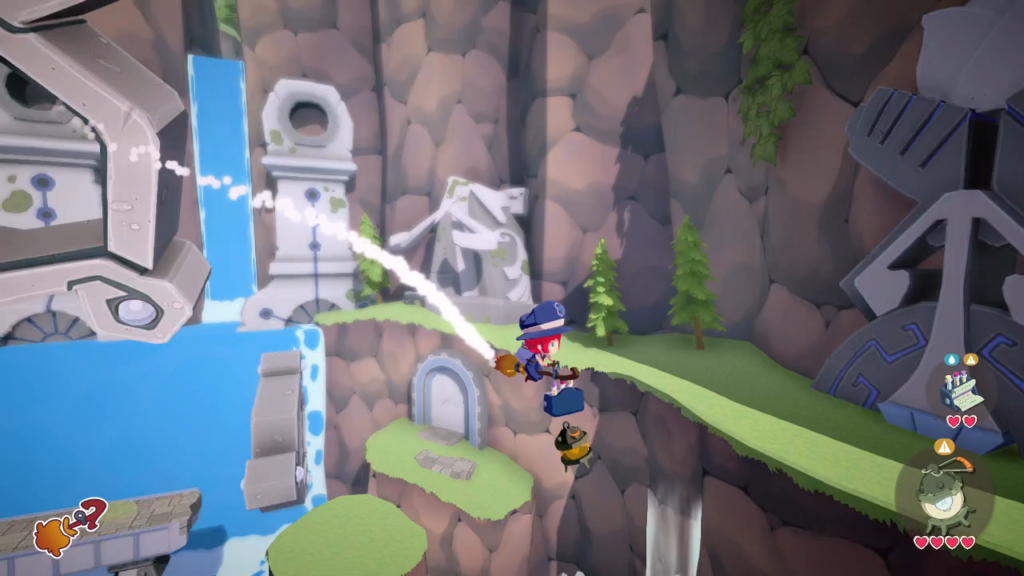
Every activity in Mika and the Witch’s Mountain is built around Mika’s broomstick. I may direct her to hop on or off the broomstick in an instant with the press of a button. While on foot, Mika moves with deliberate speed and is able to jump and stop with precision. Few places around Mont Gaun may be reached on foot; they require the greater degree of movement provided by her broomstick, which carries Mika faster and further than her feet but has squirrely turning and slides before coming to a stop. Effectively exploring the island requires me to master when Mika needs the stability provided by her feet and the agility conferred by her broomstick.
Despite the videogame’s confident assertion that Mika “flies” on her broomstick, it is actually a gliding vehicle. She begins the story using the repaired splinters of her crushed broom. This rudimentary form only allows Mika to scoot along with her feet barely leaving the ground. If she rides this broom off a cliff or rooftop, it descends slowly but inevitably back to the ground.
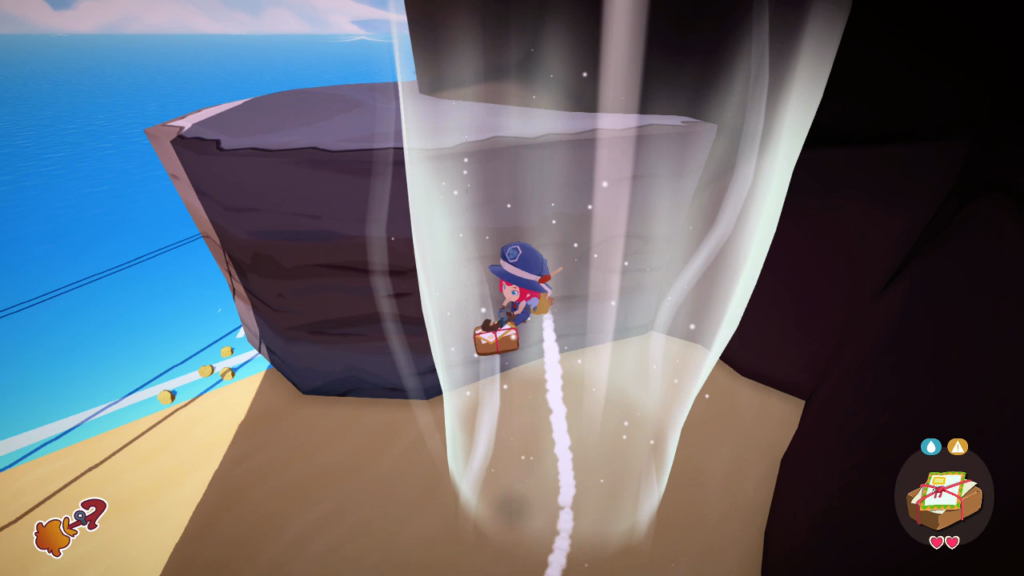
The second broom is similarly limited, though with an important modification: It can ride the columns of wind around Mont Gaun, gaining spurts of speed from horizontal columns and valuable height from vertical ones. Columns are static and form a kind of road network Mika uses to get around the island. There are additional broom upgrades beyond the second that confer new features. They never approach true flight and none are as momentous as when Mika is first allowed to glide on Mont Gaun’s magical wind currents. When she receives her second broomstick, only Miss Olagari’s Stellar Lighthouse remains out of Mika’s reach.
There are roads other than the wind currents around Mont Gaun that require a little extra effort to open. Hidden in the island’s nooks and crannies are magical orbs which may be inserted into the ancient ruins dotted around the island, transforming them into catapults which launch Mika upward. None of these launchers are needed to complete the story but taking the time to open these new paths can create interesting new possibilities for navigating the island.
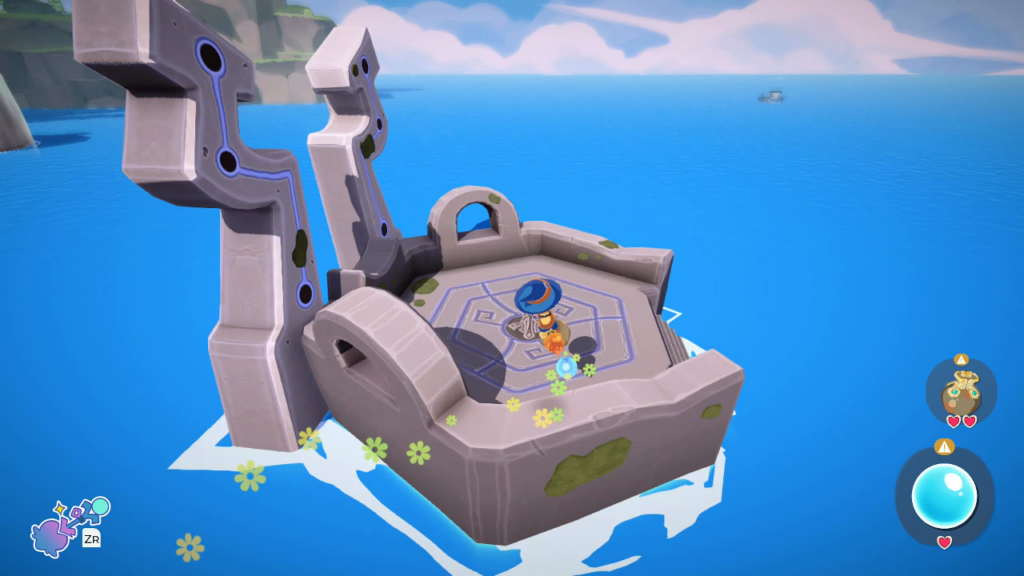
The purpose of Mika’s ability to quickly glide around Mont Gaun on her broomstick is to deliver packages for its earthbound inhabitants. Though she quickly finds employment for the Orilla Town Delivery Company, I am frustrated by her first day as a courier. It is the job of a videogame’s opening moments to establish its basic mechanics, to lay out the goals its player character must accomplish, the process they follow to complete those goals, and the consequences for failure. Greff, the surly manager of the Delivery Company, misrepresents the mechanics both to me and to Mika in ways that impact how I approach my first few hours of play.
Before assigning Mika her first delivery, Greff gives her a Stamp Card and explains the Delivery Company’s customer satisfaction system. Upon receiving their package, customers will mark Mika’s Stamp Card with a Green happy face, a Yellow neutral face, or a Red angry face, rewarded based on the speed that she makes the delivery and the condition of their package when it arrives. Mika earns a coin for a Green rating, nothing for Yellow, and will get in trouble with Greff for a Red. Mika plans to earn enough money from Green and Yellow-rated deliveries to buy a broomstick powerful enough to fly back to the Stellar Lighthouse on top of Mont Gaun.
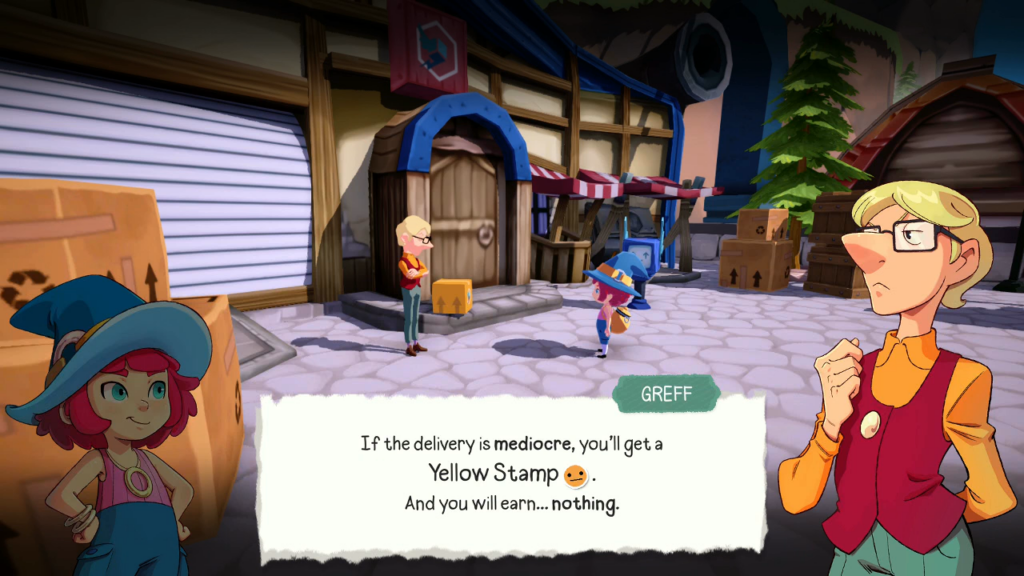
These systems as Greff outlines them would seem to describe a videogame where Mika accepts delivery jobs, completes them to the best of her ability, uses her rewards to purchase upgrades that allow her to take on harder jobs, whose greater yields are spent on better upgrades, and so on.
The problem is that none of these basic facts about Mika’s courier job as they are presented are true. A Green rating is the only valid result for completing a delivery; if Mika breaks a package by impacting surfaces with her broom or submerging it in water, instead of accepting a Red rating she must return to where the package was first picked up to spawn in a replacement and try again. The characters and systems behave as though the damage package never existed at all. With a few exceptions, how fast a package is delivered is also irrelevant. The coins Mika earns for completed deliveries are actually useless; instead of buying successively better broomsticks, she is rewarded with new ones at specific milestones in the plot. The Yellow and Red delivery ratings are likewise “earned” as part of the plot, the former given by a customer annoyed at Mika for delivering him an overdue bill, and the latter by a vindictive customer who wants to punish Mika for damage Greff caused to the package. Greff, in a discordant commentary on how workers are treated in the gig economy, is only too happy to fire his newest employee to appease the irrational customer.
Mika losing her job is the formal end of the tutorial. Though she is no longer being paid by Greff, the residents of Orilla Town still need their packages delivered and Mika is still far from earning a broom that can carry her back to the Stellar Lighthouse. She resolves to go freelance.
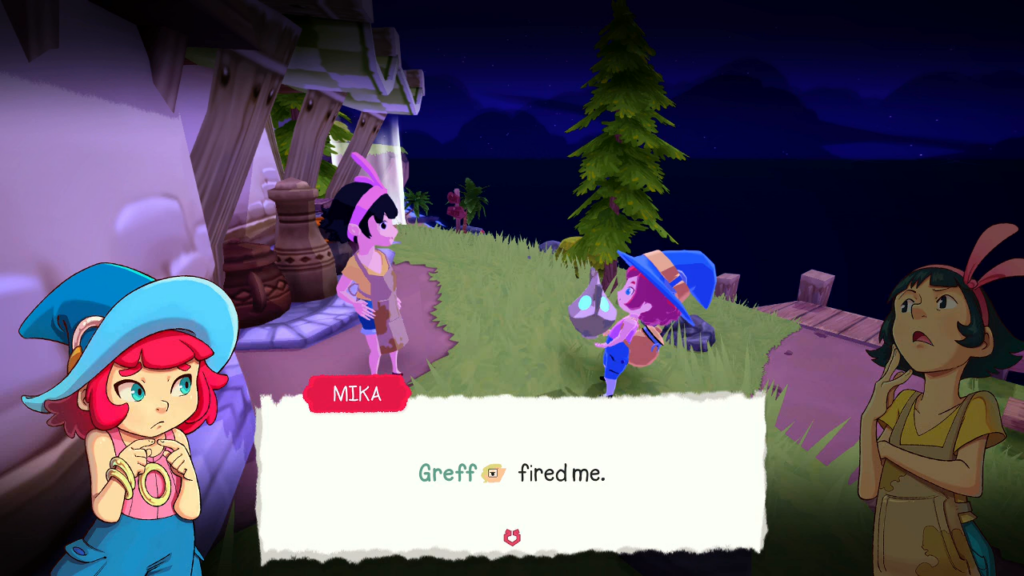
This is where the structure of Mika and the Witch’s Island completely opens up. Released from the strictures of the Delivery Company, Mika is free to wander around the island and accept any person’s request regardless of their ability to pay. Alex, a train conductor, needs magical coal to get her train running again. Retrieving the coal introduces Mika to Yulu, a lonely yeti. Getting the train running again reunites Jean Paul, a reluctant college student, with his mother Cecile, a struggling farmer. These new and reforged connections quickly reorder the society on Mont Gaun away from miserly opportunists like Greff.
Naturally, Mika’s altruistic and kind actions earn her the broomstick she needs to reach the Stellar Lighthouse, and these qualities are the real lesson Miss Olagari wishes to impart to Mika. This lesson feels unnecessary since Mika never portrays any real sense of selfishness that needs to be pressed out of her. Narrative and characterization is not where Mika and the Witch’s Mountain’s strengths are found. Mechanics are. Without Miss Olagari’s plot to address these apparent flaws in Mika’s character, there wouldn’t be a videogame based around delivering packages by broomstick, which is immensely fun and where its vision is executed best.
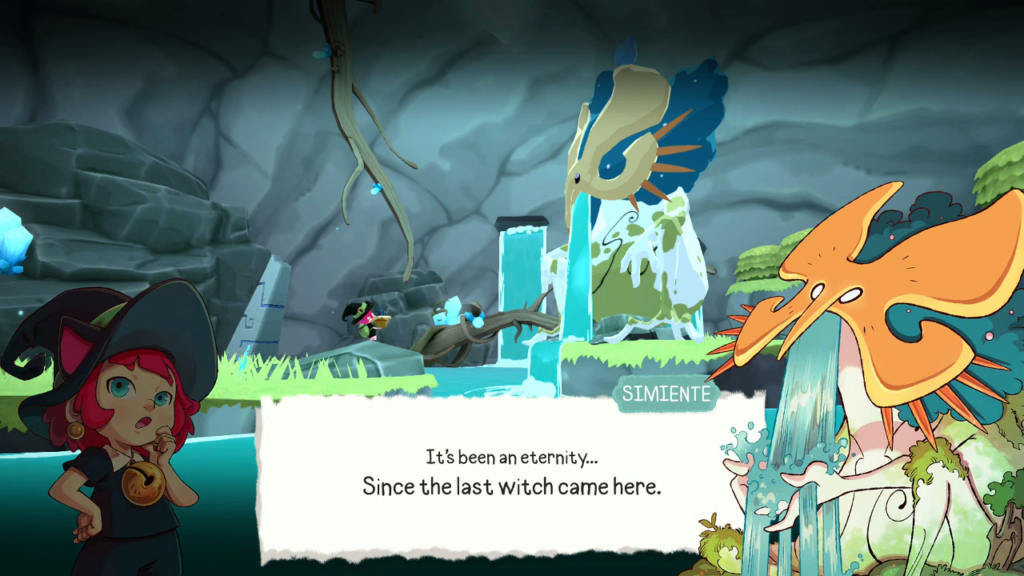
Not every item Mika delivers is as rigidly signposted as one non-player character requesting an item be delivered to another. While Mika glides around the island, she comes across more than a dozen misplaced items which she can pick up and return to their owners. For most of these items it’s a simple act of deductive reasoning to determine which of Orilla Town’s residents the lost package is intended for. Other items, particularly a CRT television set, have more inexplicable owners which require exhaustively speaking with every NPC on Mont Gaun while the item dangles from Mika’s broom. These lost packages are not a deep addition, the rewards are lackluster, and they’re inconsequential towards completing the main story. I still appreciate that their inclusion adds a couple extra hours to my playtime.
Between delivering packages, Mika can occupy her time pursuing the many optional collectables scattered around the island. Most of these are placed on precarious locations that require a bit of skill and ingenuity to reach. Tiny Napopo statuettes are found on almost every rooftop, cliff, and spire. They may be exchanged at a magical shrine for new clothes that Mika can wear and charms she can dangle from her broomstick. Other shrines gift Mika with new Witch Trails, the magical energy that trails in the wake of her broomstick, adding whimsical flourishes like rainbows and blooming flowers to Mika’s travels.
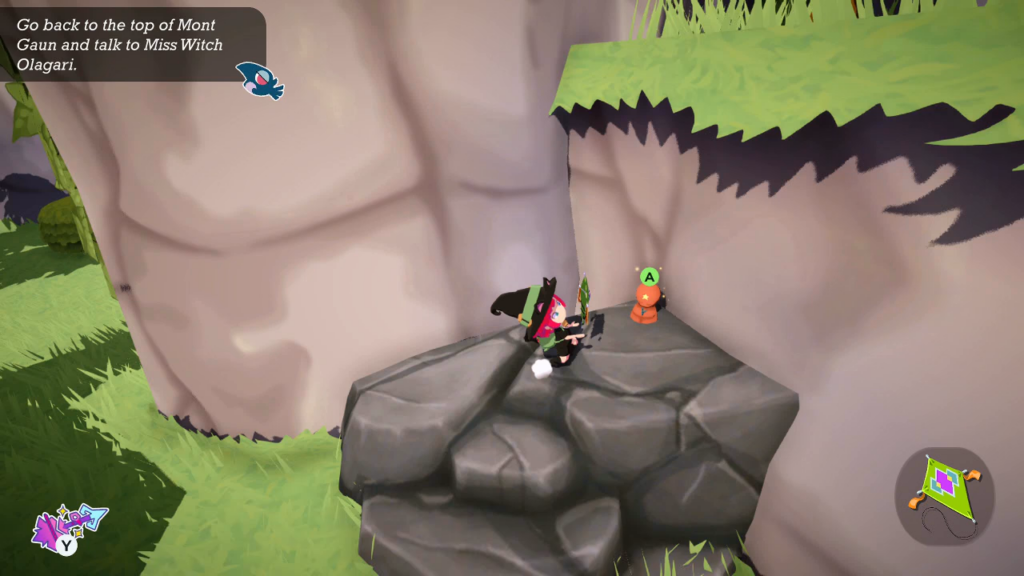
The most difficult collectable to gather are the Tarot Cards. Found around Mont Gaunt are massive Simiente Jars. These may only be opened if Mika can land on top of them with enough force. This nearly always requires her to glide on her broomstick high above the jar and leap off, aiming to land on the jar’s top; thankfully Mika suffers no physical damage even if she jumps from the top of the Stellar Lighthouse, so the only penalty for missing is having to climb back up to try again. Breaking open a jar rewards Mika with Tarot Cards, each of them depicting a citizen of Orilla Town as one of the Tarot figures. Despite being the most difficult objects to collect, the Tarot Cards offer no discernible reward. They trade high effort for little satisfaction.
Mika and the Witch’s Island is divided into four distinct days. The first two days are spent working for the Delivery Company. The fourth follows Mika’s ascent to the Stellar Lighthouse. The third day, while occupying about half my playtime, is Mika’s time as a freelancer. I wish she spent one or two more days in this role. If this videogame were exactly as long as I wanted it to be, I could call it a perfect game. Instead it is a short videogame that leaves me wanting more than its five to six hour playtime. This is still preferable to a videogame I like and feel is too long.
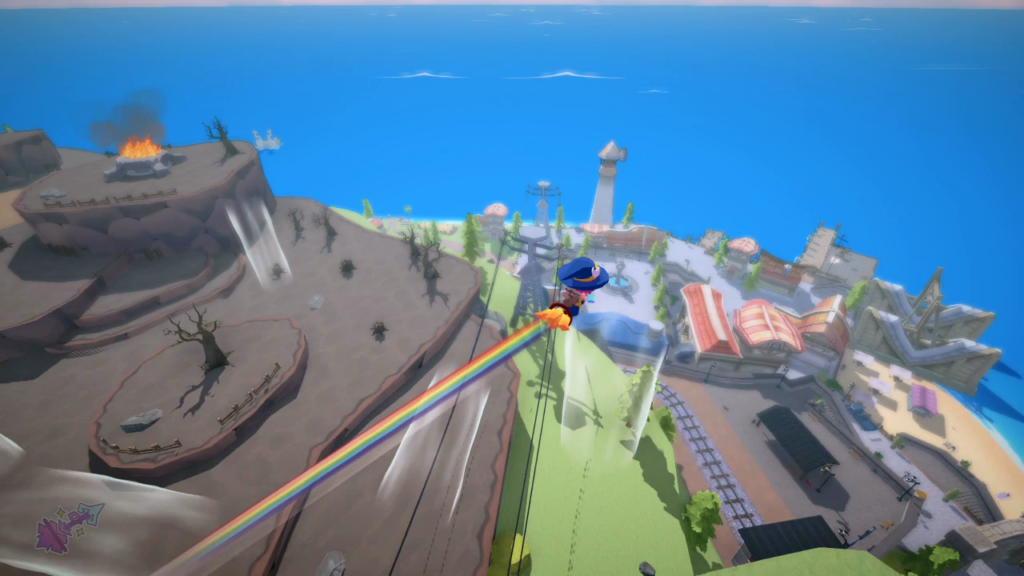
The best parts of Mika and the Witch’s Mountain are its mechanics. Delivering packages around a magical island filled with ancient ruins is a great idea, enhanced by Mika’s broomstick which is easy to control while being just imprecise enough that handling it feels like an actual skill. It’s unfortunate that I get off to an uncertain start with Mika’s courier job due to Greff’s misrepresentations, but once the witch apprentice sets out on her own I begin to truly enjoy myself. My only complaint is Mika learns her lesson much too soon, bringing the adventure to an end long before I have been satisfied. If the worst thing I can say about a videogame is I liked it so much I wish it were longer, that’s a videogame worth a player’s time.